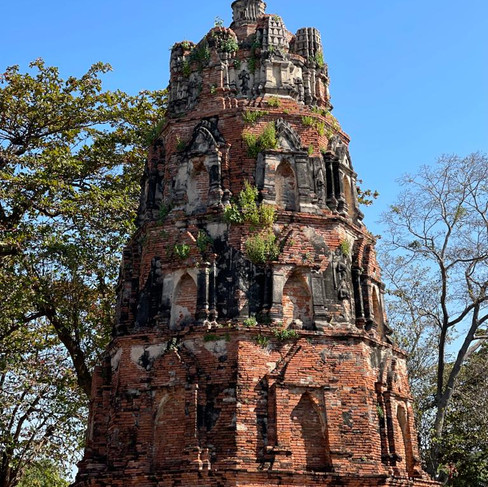Wat Mahathat Temple in Ayutthaya, Thailand
- Walter Ponce
- Apr 4, 2022
- 3 min read
Updated: 7 days ago
During some of my trips to Thailand, I had the chance to visit Wat Mahathat.
The first time was in 2019 with a good Thai friend. We managed to explore all the temples in Ayutthaya on our own. It was incredibly hot—I remember sweating like crazy—but it was also the perfect time to go. Thailand had just reopened to tourists after COVID, so the temples were quiet, with very few visitors around. We really got to enjoy the peaceful atmosphere.
My second visit was with my mother. We were staying in Bangkok at the Four Points by Sheraton and decided to book a guided tour through the hotel. Honestly, the service wasn't great—the guide wasn’t very engaging or friendly—but overall, it was still a meaningful experience for both me and my mom. This visit was around 2022, still post-COVID, but the temples were noticeably busier compared to 2019.
Wat Mahathat History
If the Ayutthaya Ruins are one of the most important historical complexes in Thailand, the Temple or Wat Mahathat is undoubtedly one of the most visited of the entire site. Famous for housing the famous Buddha Head in its ruins, Wat Mahathat has become one of the best-known photographs in the whole country and almost a symbol of Thailand.
To know the origin of the temple one must go back to the period of maximum splendor of the Kingdom of Ayutthaya. During the reign of Borommaracha I in 1371, Ayutthaya was still under the influence of the Khmer Empire, which is evident in the architectural style of the temple, with its central Chedi or Prang (now totally collapsed but believed to have been have a height close to 40 m) and its four towers or Viharas in each corner of the enclosure and all of them surrounded by an exterior wall decorated with small statues, currently without heads but which at the time were one of the most important parts From the temple.
During all the time that Ayutthaya had its historical importance, the Temple or Wat Mahathat was one of the most important and sacred places in the city. The entire complex is decorated with moats and ponds, following the Khmer-style architectural line. One of the most important corners of the temple is the famous tree with the head of Buddha.
The legend says that during the Burmese invasion that destroyed the temple, one of the signs of domination that took place was the beheading of all the Buddha figures that were in the temple. One of the monks buried one of these heads that was protected by the roots of the tree. Today it is undoubtedly one of the most important photographs of the entire Ayutthaya complex.
One of the most interesting features for tourists visiting Wat Mahathat is surely the famous Buddha head that is embedded inside a trunk , surrounded by roots that have grown around it, and the truth is that nobody knows for sure It is certain how it was that this stone figure and the roots of the tree ended up intertwining until they became a single fused piece that makes everyone who passes by marvel at such a peculiarity.
One of the most popular theories, and that sounds more logical, is that the tree simply grew around the head of this statue while the temple was abandoned and full of weeds , but the curious thing is that precisely the fraction of the face is what that is discovered.

Other people say that it was a thief who moved this figure of the Buddhist deity to the place where it is now, stealing it from the main temple. He tried to hide the Buddha in that place but later he could not pick it up and what happened happened.
The Wat Mahathat monastery was destroyed in the year 1767 during the invasion of the Burmese in the war between Burma and the kingdom of Siam, so many of the Buddha images were beheaded or simply destroyed. This is why the area remained abandoned until the 1950s, when restoration work began to make Wat Mahathat the tourist spot it is today.








Comentarios